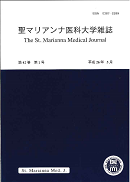Volume 48, Issue 4
Displaying 1-5 of 5 articles from this issue
- |<
- <
- 1
- >
- >|
review
-
2021Volume 48Issue 4 Pages 177-182
Published: 2021
Released on J-STAGE: April 12, 2021
Download PDF (2391K) -
2021Volume 48Issue 4 Pages 183-189
Published: 2021
Released on J-STAGE: April 12, 2021
Download PDF (1228K)
original article
-
2021Volume 48Issue 4 Pages 191-196
Published: 2021
Released on J-STAGE: April 12, 2021
Download PDF (598K) -
2021Volume 48Issue 4 Pages 197-210
Published: 2021
Released on J-STAGE: April 12, 2021
Download PDF (2970K)
-
2021Volume 48Issue 4 Pages 211-217
Published: 2021
Released on J-STAGE: April 12, 2021
Download PDF (708K)
- |<
- <
- 1
- >
- >|
